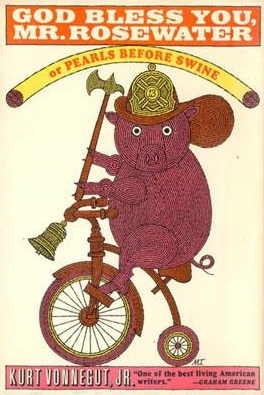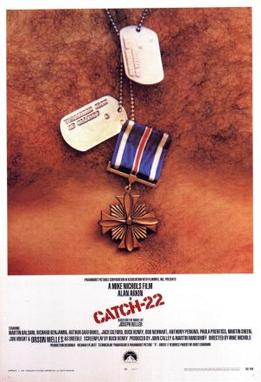
Kurt Vonnegut was an American writer and humorist known for his satirical and darkly humorous novels. In a career spanning over 50 years, he published fourteen novels, three short-story collections, five plays, and five nonfiction works; further collections have been published after his death.

Catch-22 is a satirical war novel by American author Joseph Heller. He began writing it in 1953; the novel was first published in 1961. Often cited as one of the most significant novels of the twentieth century, it uses a distinctive non-chronological third-person omniscient narration, describing events from the points of view of different characters. The separate storylines are out of sequence so the timeline develops along with the plot.

Slaughterhouse-Five, or, The Children's Crusade: A Duty-Dance with Death is a 1969 semi-autobiographic science fiction-infused anti-war novel by Kurt Vonnegut. It follows the life experiences of Billy Pilgrim, from his early years, to his time as an American soldier and chaplain's assistant during World War II, to the post-war years. Throughout the novel, Billy frequently travels back and forth through time. The protagonist deals with a temporal crisis as a result of his post-war psychological trauma. The text centers on Billy's capture by the German Army and his survival of the Allied firebombing of Dresden as a prisoner of war, an experience that Vonnegut endured as an American serviceman. The work has been called an example of "unmatched moral clarity" and "one of the most enduring anti-war novels of all time".

Something Happened is Joseph Heller's second novel. Its main character and narrator is Bob Slocum, a businessman who engages in a stream of consciousness narrative about his job, his family, his childhood, his sexual escapades, and his own psyche. Although Something Happened failed to achieve the level of renown that Catch-22 did, it has since developed a cult following, with some considering it one of Heller's finest works.

God Bless You, Mr. Rosewater, or Pearls Before Swine, Kurt Vonnegut's fifth novel, was published in 1965 by Holt, Rinehart and Winston and as a Dell mass-market paperback in 1970. A piece of postmodern satire, it gave context to Vonnegut's following novel, Slaughterhouse-Five and shared in its success.
First Lieutenant Milo Minderbinder is a fictional character in Joseph Heller's 1961 novel, Catch-22. As the mess officer of Yossarian's squadron, Minderbinder is an entrepreneur during World War II, "perhaps the best known of all fictional businessmen" in American literature. The Minderbinder character is a "bittersweet parody" of the American dream, both a "prophet of profit" and the "embodiment of evil". Minderbinder also appears in Heller's 1994 sequel Closing Time.
Edward J. Nately III is a fictional character in Joseph Heller's satirical 1961 novel Catch-22.
Kilgore Trout is a fictional character created by author Kurt Vonnegut. Trout is a notably unsuccessful author of paperback science fiction novels.
Lieutenant Orr is a fictional character in the classic 1961 novel Catch-22 by Joseph Heller. Orr is a World War II bomber pilot who shares a tent with his good friend, the protagonist of the novel, Yossarian. Described as "a warm-hearted, simple-minded gnome," Orr is generally considered crazy. His most notable feature is repeatedly being shot down over water, but, until his final flight, always managing to survive along with his entire crew. On his final flight, perhaps two-thirds of the way through the novel, he is again shot down into the Mediterranean, and is lost at sea. Only in the last ten pages of the novel does Heller reveal that Orr's crashes were part of an elaborate plot to escape the war.
Chaplain Captain Albert Taylor Tappman is a fictional character in Joseph Heller's 1961 novel Catch-22 and its 1994 sequel Closing Time. In earlier editions he was called Chaplain Robert Oliver Shipman, but this was changed to Albert Taylor Tappman. Editions published in some other territories, notably Britain, have continued to use the original name. Heller named the character after Charles Allan Tapman, a Penn State University boxer and Class of 1938 graduate that Heller met socially in the early 1950s.
Colonel Cathcart is a character in Joseph Heller's novel Catch-22 (1961) and the novel's de facto main antagonist.
Captain "Aarfy" Aardvark is a fictional character, a major antagonist in the 1961 novel Catch-22 by Joseph Heller. Aarfy is the plump navigator in Yossarian's B-25, noted for being oblivious to incoming flak, getting lost on missions, and his omnipresent pipe. His nickname "Aarfy" is an abbreviation of his surname, Aardvark.

A catch-22 is a paradoxical situation from which an individual cannot escape because of contradictory rules or limitations. The term was coined by Joseph Heller, who used it in his 1961 novel Catch-22.

Palm Sunday is a 1981 collection of short stories, speeches, essays, letters, and other previously unpublished works by Kurt Vonnegut.

Catch-22 is a 1970 American satirical black comedy war film adapted from the 1961 novel of the same name by Joseph Heller. In creating a black comedy revolving around the "lunatic characters" of Heller's satirical anti-war novel set at a fictional Mediterranean base during World War II, director Mike Nichols and screenwriter Buck Henry worked on the film script for two years, converting Heller's complex novel to the medium of film.

Portrait of an Artist, as an Old Man is a novel by Joseph Heller, published posthumously in 2000. His final work, it depicts an elderly author as he tries to write a novel that is as successful as his earlier work, mirroring Heller's own career after the success of Catch-22.

Joseph Heller was an American author of novels, short stories, plays, and screenplays. His best-known work is the 1961 novel Catch-22, a satire on war and bureaucracy, whose title has become a synonym for an absurd or contradictory choice. He was nominated in 1972 for the Nobel Prize in Literature.
Catch-22 is a satirical play by the American author Joseph Heller, first produced in 1971 and based on his 1961 novel of the same name.

Face of a Hero is a novel written by American writer Louis Falstein and published in 1950. Though out of print for a long time, interest in this narrative, dealing with the war experience of a B-24 tail gunner in Southern Europe during the Second World War was rekindled when it was suggested that it inspired Joseph Heller while writing his well-known war novel Catch-22.








